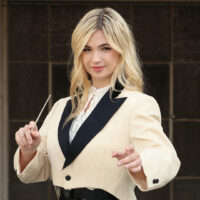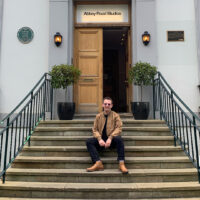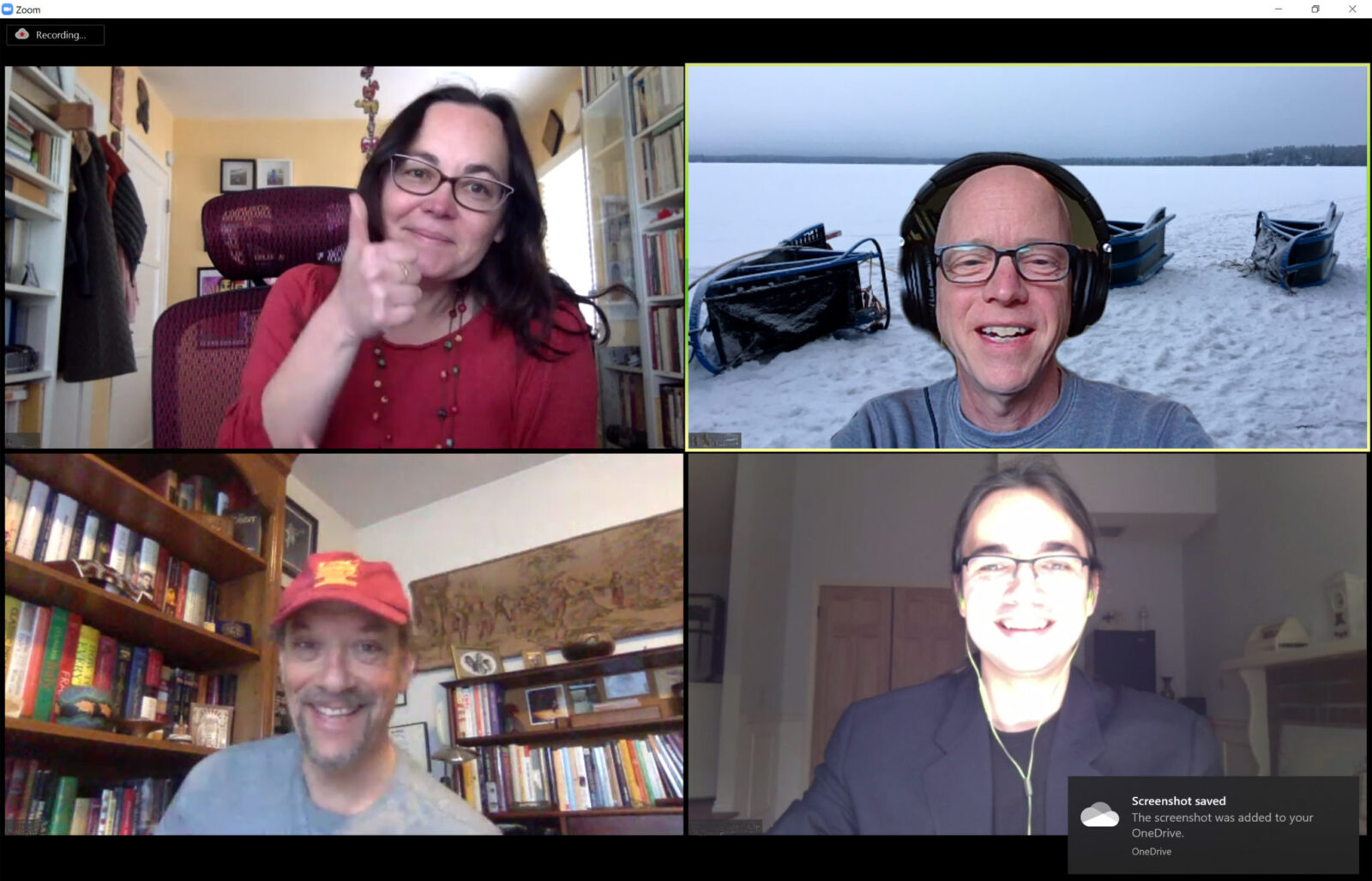
All Together Now
By Julie Riggott
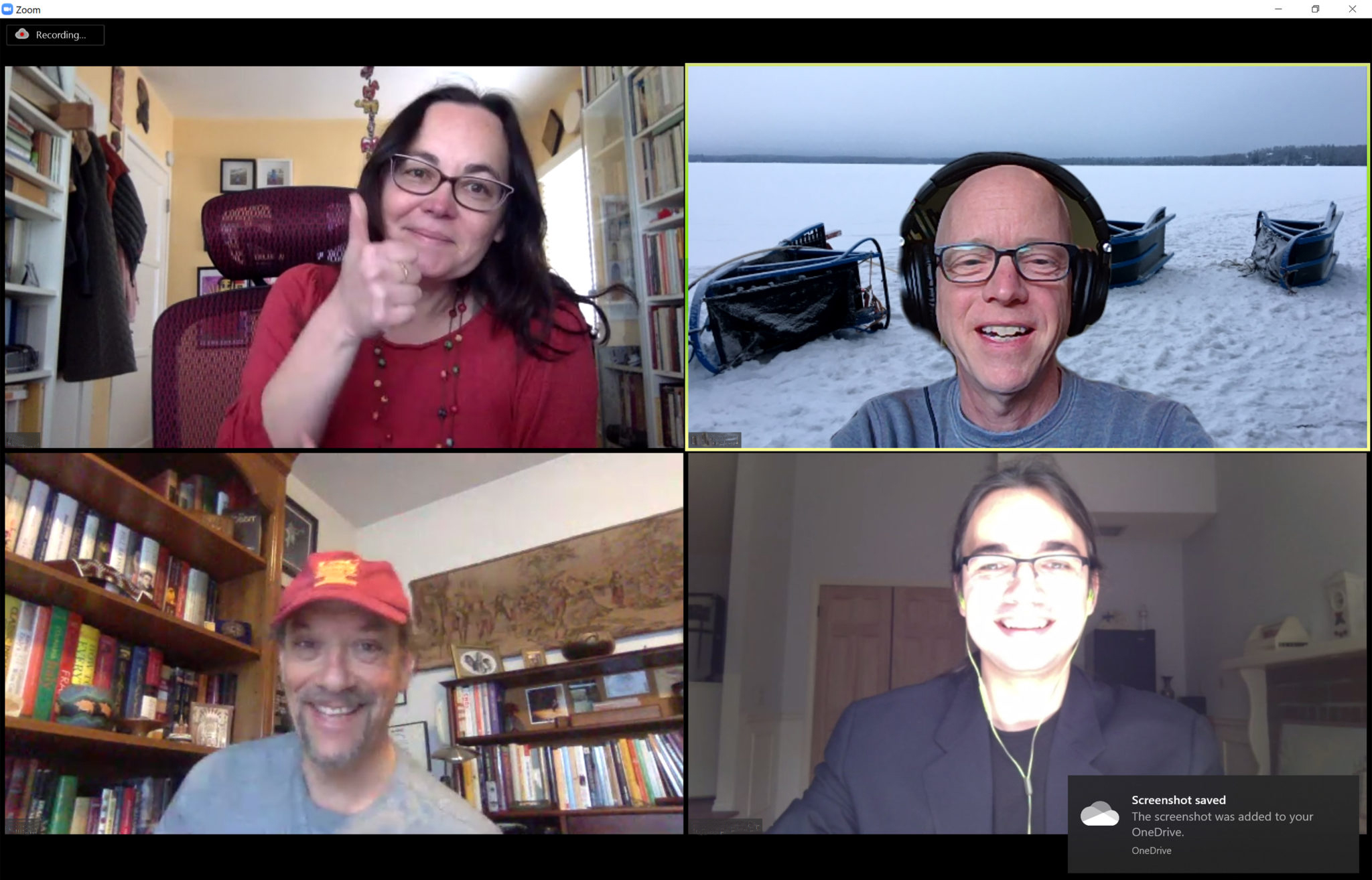
Brian Head leads a DMA exam over Zoom. Clockwise from top left: Beatriz Ilari, Music Teaching & Learning professor; Brian Head, Classical Guitar professor and Associate Dean for Academic Affairs; Tomasz Fechner, DMA candidate; and Bill Kanengiser, Classical Guitar professor. (Photo courtesy of Head)
USC Thornton faculty rethink the curriculum to maximize opportunities for musicians practicing social distancing.
Imagine sitting in a room with a chamber music quartet performing a Mozart string quartet. You can catch every nuance of tone, texture, dynamics and articulation in the musicians’ playing. You can hear and see the musicians in full color.
Now adjust the picture. Everyone is in a different location, seeing and hearing each other on a video-conferencing platform. The listener has to mute all but one player at a time. The sound, filtered and transmitted through an electronic device, is less vivid and clear. It’s definitely not the same Mozart string quartet — it’s not even accurate to call it a quartet.
Now you understand one of the biggest challenges facing the USC Thornton School of Music after COVID-19 forced classes to go online. How do professors continue to teach music when they and their students are required to shelter in place and engage in physical distancing?
“One of the things that separates us in music from most of the other academic disciplines and gives us a kinship with the other performing arts is the fact that so much of what we do is intrinsically communal,” said Brian Head, associate dean for Academic Affairs. “What most of our students in the performance area are doing as a matter of course, the reason they come to study at a music school, is to play shoulder to shoulder with other musicians. That’s the fundamental challenge that we face in a quarantine situation.”
When the University administration first announced that classes would move online on March 11, Thornton needed to quickly figure out how to teach classes remotely, and Head began an intensive and comprehensive review of the school’s curriculum, leading faculty in adjusting to the new realities of online instruction.
While traditional lecture-style classes, like music theory, history and pedagogy, could be relatively seamlessly taken online, music lessons, performances, ensemble rehearsals and the like would require more innovative solutions. The Thornton faculty have been in constant conversation about how to move forward and have already responded with various innovations.
Sound Check & Multi-Tracking
The school’s initial preferred platform is Zoom, but the software has been optimized for speech. “In so optimizing, it defeats certain musical qualities, sustain being primary among them,” Head said. One setting has been a game changer for singers and instrumentalists: “original sound.”
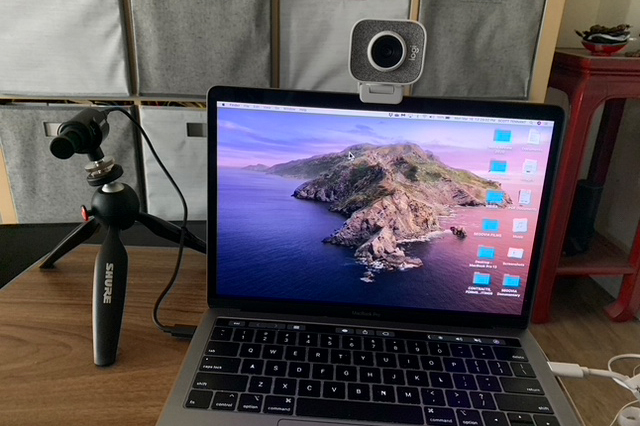
With the addition of USB microphones, Scott Tennant and his students have been able to get the most out of Zoom’s audio capabilities. (Photo courtesy of Tennant)
“This turns off compression, and you can hear a bigger range of sound,” said Scott Tennant, chair of the Classical Guitar program. Before he discovered this sound setting, instruction was nearly impossible: “All the guitars sounded like banjos with rubber bands on them.”
One limitation right now is that the original sound setting does not extend to mobile devices. “That footnote is devastating to a large proportion of our students who are using iPads or iPhones, instead of laptops or desktops,” Head said. “We are working through the IT Department at USC to advocate for Zoom to extend the setting to mobile devices. It wasn’t a concern until this move to online instruction.”
Other peripherals have helped sound quality. Tennant’s department found money in the budget to send a USB external microphone to every guitar major. “With an external mic and original sound in Zoom turned on, you’re getting the maximum range of sound and resonance you can get online,” Tennant said.
The department is planning for Spanish maestro Pepe Romero to go ahead with his twice-annual master class on Zoom. They are also looking at livestreaming their DMA recitals.
“We’re doing all of this for the students,” Tennant said. “They’re the No. 1 — they’re the only priority.”
Of course, as far as performance classes go, classical guitar is probably the best-case scenario for remote learning. It’s a solo instrument. “The biggest nut to crack is rehearsing and actually executing an ensemble performance,” Head said. This will impact recitals and juries as well.
Live! From Somewhere
Right now, the general population has been excited and inspired by multi-track virtual ensemble performances being shared online — musicians performing together in video “squares.” Many departments at Thornton, like Popular Music and Jazz Studies, are already using this technology and set to soon release ensemble performances online.
On Monday, March 16, the first day of Spring Break, USC Thornton launched Live! From Somewhere, a virtual stage featuring Thornton students, alumni, and faculty performing live from living rooms, back patios, garages — wherever they found themselves. In its first week or video performances, the series was viewed over 250,000 times on the school’s Facebook page.

Students like Max Opferkuch have found fun and creative ways to use technology for their Live! From Somewhere performances. For his video, Opferkuch digitally cloned himself to be able to accompany his own performance.
This series has been a celebrated first response to the cancellation of events, but it’s an online performance series dictated by guidelines Thornton drew up that require students to adhere to social distancing.
“This performance series has been a welcome gesture to the Thornton community and audience,” said Robert Cutietta, Dean of USC Thornton. “The students and alumni have shown such creativity in their videos, but it’s fundamentally different than playing a concert together. It’s much closer to a recording project.”
For now, ensemble performances with the USC Thornton Symphony remain a key challenge. That doesn’t mean that Thornton faculty are not brainstorming and actively seeking solutions. USC alumnus and Judge Widney Professor of Music at USC Michael Tilson Thomas famously conducts the New World Symphony, a professional training orchestra in Miami, from a studio in San Francisco — even in live performances. But of course, the orchestra is together in an immersive video/audio hall. While that exact idea cannot be adopted, it can get faculty thinking about other uses of the technology. And in the meantime, master classes online, colloquia about rehearsal technique and guest lectures from well-known composers can be valuable alternatives.
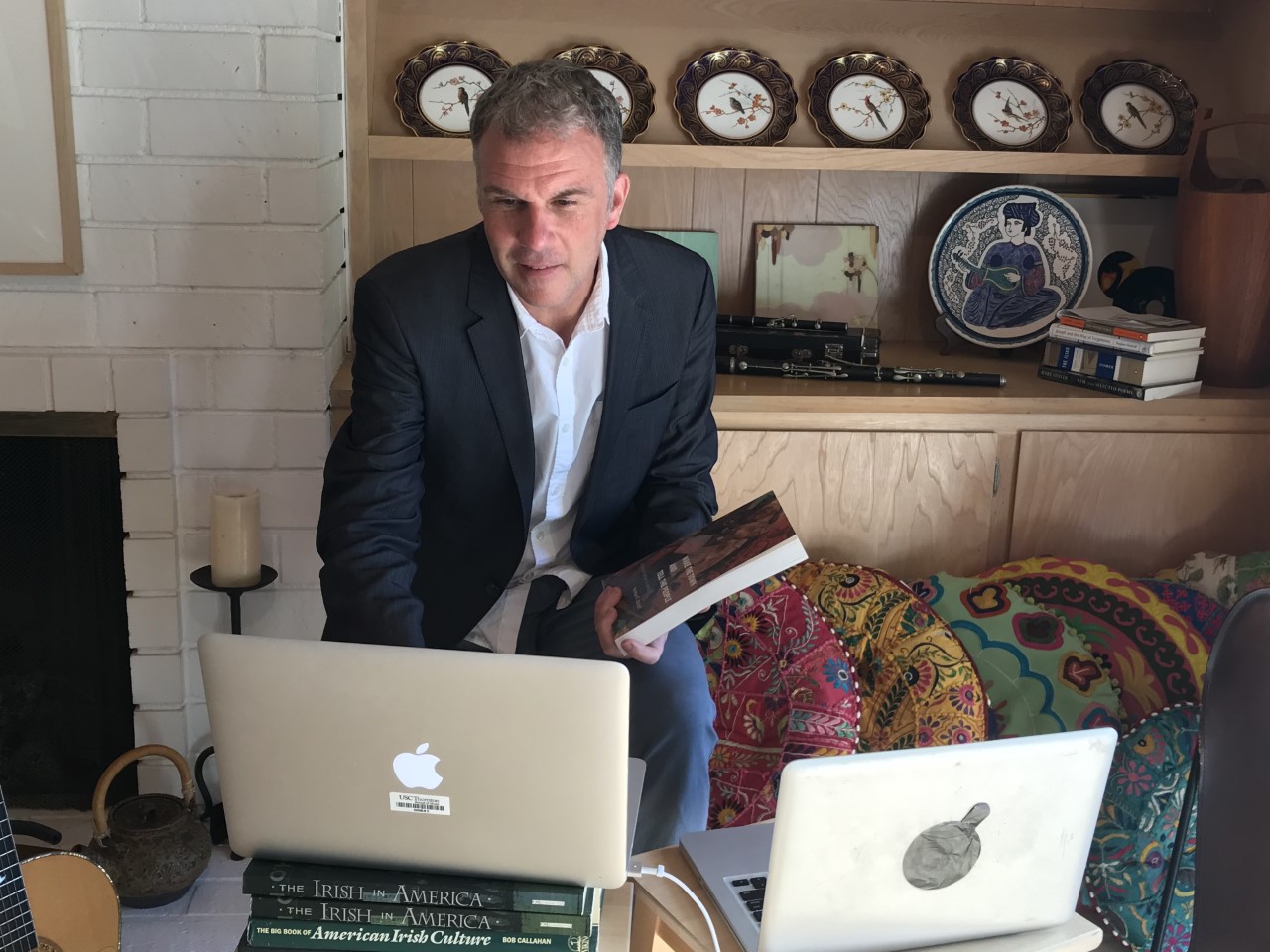
Musicology faculty member Scott Spencer has adapted to new technologies to teach academic courses. Here, he leads a World Music class from his living room. The 150 students in the class are scattered across Los Angeles, the United States, and the world. (Photo courtesy of Spencer)
Professor of Musicology Joanna Demers, vice dean of the Scholarly and Research Studies Division, oversees a division of traditionally academic work, with the exception of the Early Music program. “One of the core strengths of the program is that it has been able to teach students how to improvise in medieval and renaissance music. Now how do you do that in an online environment?”
Director of Early Music Adam Knight Gilbert is experimenting with multi-tracking. One student records the bass line and then sends the file to another student who improvises over it and so on. “It’s not perfect, it’s not what we would prefer, but given the circumstances it works,” said Demers. “We’re optimistic that we’re going to make this work for however long we need to. We’re all in it together.”
Studio Substitute
Thornton’s Screen Scoring program had several recording sessions scheduled on professional recording stages with studio musicians this semester. They are now experimenting with innovative ways to simulate ensembles of string, woodwind and brass quintets.
“We are engaging a professional engineer to work with our composers in preparing guide tracks of their compositions that can be passed via digital files to musicians who have recording facilities in their homes or private studios,” said Daniel Carlin, chair of the Screen Scoring program and vice dean of the Division of Contemporary Music.
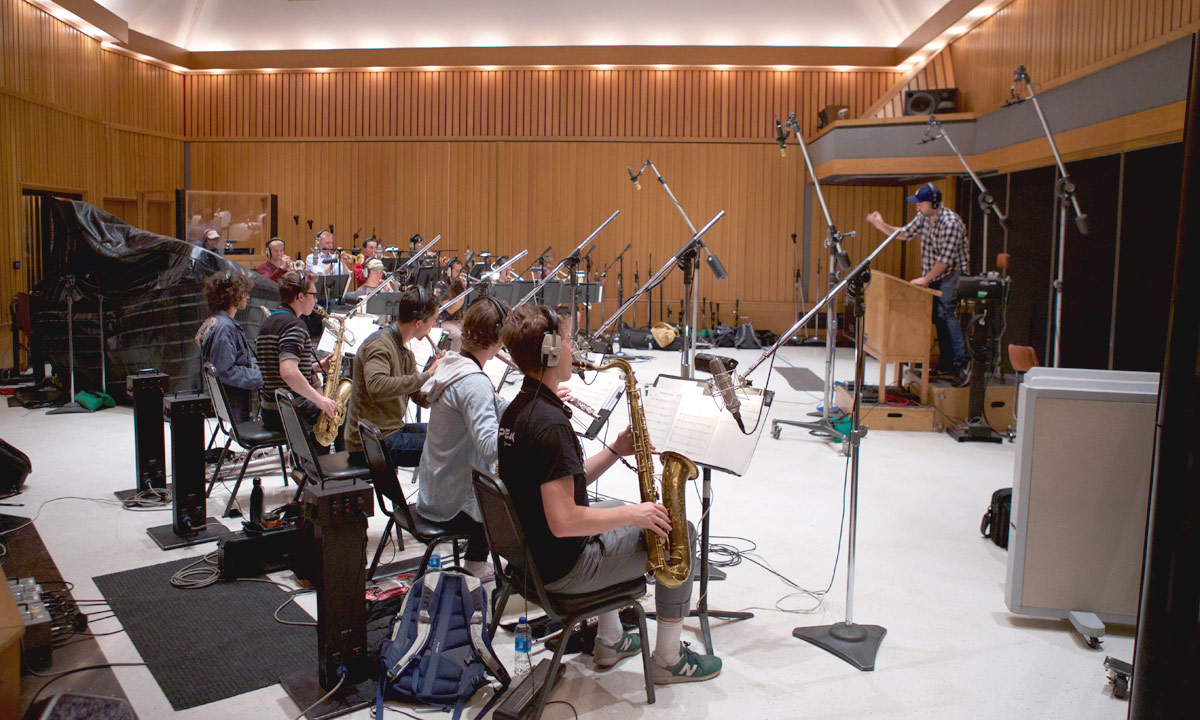
Without the ability to bring musicians together in a traditional sound stage, such as the Capital Records stage pictured here, the USC Thornton Screen Scoring program seeks custom engineering solutions to allow ensembles to create music from afar. (Photo: Dario Griffin/USC)
After the first musician, say a violinist, plays the first and second parts, the “sweetened” track will come back to the engineer, who will prepare it for the next player — likely another violinist who will play along with the first violinist’s work. The engineer then does another mix and preparation, and sends the file onto, say, the French horn player, who pays the horn parts. It continues like that until all the parts are recorded, after which the engineer will mix everything and return it to the student for grading and archiving.
“Given the time and labor, it would be completely impractical to attempt this with more than a dozen or so musicians,” Carlin said, “but at least we’ll have some semblance of an organized ensemble.”
“This is a cool version of multi-tracking on a grand, professional level,” Head said. “Composers are always looking for innovative solutions, so there is some excitement for them, and they are more likely to be conversant with the software.”
Apps and Master Classes
In addition to Zoom, the Jazz Studies department is looking at audio and video recording equipment. “If students record themselves and send us a file, we can get a much better sense of the sound they are producing with their instruments,” said Peter Erskine, director of Drumset Studies.

With the help of various innovative apps and digital tools, Peter Erskine continues lessons with drum students. (Photo courtesy of Erskine)
When all this brainstorming started in the first couple weeks of the pandemic, Erskine woke up in the middle of the night with an idea. He had developed a series of play-along apps, and he wanted to give them to the Jazz Studies and Studio Guitar majors. “This was in part to give us a means for the students to play in an ensemble, which is an important component of their end-of-the-year jury performance,” he said.
“For years musicians have utilized ‘music minus one’ recordings, where it’s kind of like karaoke: you buy an LP or tape or CD and play along with a professional rhythm section,” Erskine said. With his app, he wanted to take that a step further. “Let’s put this play-along in an environment where the end user can create their own mix of instruments. A pianist could remove the piano, a bass player could remove bass, or someone could use it as a karaoke track, and they record themselves.” Students could send the file to their teacher. “I saw it as a way of enhancing the teacher-student relationship a few years ago,” Erskine said.
The apps became a joint project with Erskine’s fellow faculty members. The Jazz Essentials 1 and 2 apps feature Erskine, Alan Pasqua and Darek Oles. The Afro-Cuban app features Aaron Serfaty; and the Big Band app uses Bob Mintzer’s charts and features Mintzer, Erskine, Serfaty, Edwin Livingston, Russell Ferrante, John Thomas and Bob Sheppard. They are foregoing royalties so that the students can have the technology for free.
Erskine has also hooked up the drum students with a free subscription to ArtistWorks, a video exchange system he uses for his private lessons. “Students can send music or questions via video, and I make a unique video for each recording I receive,” Erskine said. He has recorded content over the past few years that has been edited into 200 lessons. “The cool thing is that all students that are part of ArtistWorks can access all the videos — so it’s like a master class at each person’s convenience.”
With these innovations, Erskine said, “I’m just following the great example set by the folks at the top at USC. It’s in everyone’s best interest that we adapt to this new paradigm. We’re all hopeful that come autumn, we will all be able to meet and even shake hands on our beloved campus.”
Fight On!
All of the faculty and students are eager to get back together. “Music is a social endeavor,” Carlin said. “It is difficult for us all to remain isolated while trying to make music collectively.”
Solo practice has also been interrupted for many. “Most of our students are encountering severe curtailment of their ability to practice as they normally would,” Head said. Consider pianists or percussionists who don’t have instruments at home or the trumpet player who shares an apartment with four roommates and thin walls, for only a few examples.
Thornton has begun trying to address these issues with creative solutions. After sending a hardship survey to students, Jefferey de Caen, the associate dean for operations, identified many students in need of instruments, particularly pianists, percussionists, and drummers.
This week, as many as 20 electronic pianos have been rented and delivered to students in their homes. Percussion and drum kit solutions are also set to make their way to students.
“Our proposed solutions to the related challenges are yet to be tested,” Carlin said, “but what is most gratifying is to witness the enthusiasm that our faculty and students bring to this experiment. Especially given the worrisome conditions brought about by this pandemic, you can’t help but admire the spirit of our community in helping each other through the crisis.”
